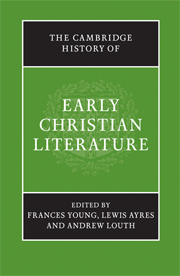Book contents
- Frontmatter
- PART ONE The Beginnings: The New Testament to Irenaeus
- PART TWO THE THIRD CENTURY
- A LITERARY GUIDE
- 11 The Alexandrians
- 12 The beginnings of Latin Christian literature
- 13 Hippolytus, Ps.-Hippolytus and the early canons
- 14 Cyprian and Novatian
- 15 The earliest Syriac literature
- 16 Concluding review: the literary culture of the third century
- B CONTEXT AND INTERPRETATION
- PART THREE FOUNDATION OF A NEW CULTURE: FROM DIOCLETIAN TO CYRIL
- Bibliographies
- Index
- Map: The Roman Empire in the late fourth century AD"
- References
15 - The earliest Syriac literature
from A - LITERARY GUIDE
Published online by Cambridge University Press: 28 March 2008
- Frontmatter
- PART ONE The Beginnings: The New Testament to Irenaeus
- PART TWO THE THIRD CENTURY
- A LITERARY GUIDE
- 11 The Alexandrians
- 12 The beginnings of Latin Christian literature
- 13 Hippolytus, Ps.-Hippolytus and the early canons
- 14 Cyprian and Novatian
- 15 The earliest Syriac literature
- 16 Concluding review: the literary culture of the third century
- B CONTEXT AND INTERPRETATION
- PART THREE FOUNDATION OF A NEW CULTURE: FROM DIOCLETIAN TO CYRIL
- Bibliographies
- Index
- Map: The Roman Empire in the late fourth century AD"
- References
Summary
Although Jesus and his apostles undoubtedly used Aramaic as their main language of communication, nevertheless we know singularly little about the early spread of Christianity among the Aramaic-speaking population of the eastern provinces of the Roman Empire (covering approximately modern SE Turkey, Syria, Lebanon, Jordan and Israel) and of the Parthian Empire further east. In view of this lack of information particular interest is attached to the earliest surviving Syriac literature, most of it belonging to the third and fourth centuries, since this offers the best evidence for the distinctive character of Aramaic-speaking Christianity in a milieu that was for the most part still comparatively unHellenized.
It is likely that some time before the end of the second century AD a large proportion of Aramaic-speaking Christians came to adopt as their literary language the local Aramaic dialect of Edessa, known today as Syriac. Inscriptions in this dialect, which has its own distinctive script, are already known from the first century AD, and from the mid-third century there survive three legal documents from Edessa (modern Urfa in SE Turkey) and its vicinity. As will be seen, it is likely that Syriac had already been adopted as a literary language by local Jews as well as by pagans before it was taken up by Aramaic-speaking Christians.
Keywords
- Type
- Chapter
- Information
- The Cambridge History of Early Christian Literature , pp. 161 - 171Publisher: Cambridge University PressPrint publication year: 2004
References
- 2
- Cited by



